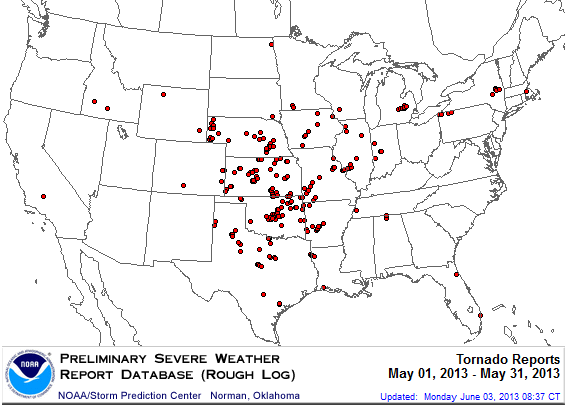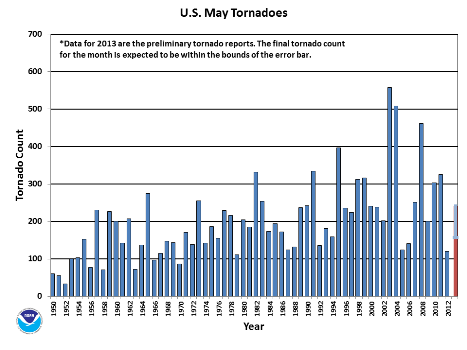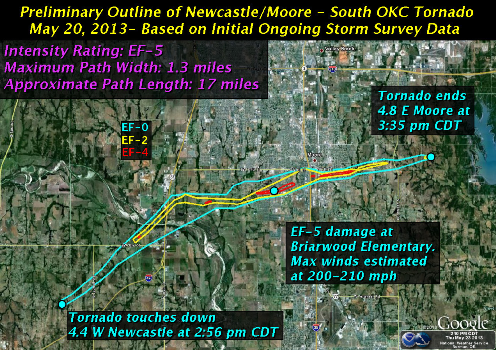
May 2013 Tornado Occurrences
Source: SPC
According to data from the Storm Prediction Center, during May there were 242 preliminary tornado reports. This is slightly below the 1991-2010 average of 276 May tornadoes. May is climatologically the most active tornado month of the year. Despite the below-average number of tornadoes, May 2013 marked the most tornadoes of any month since May 2011, and the first month since May 2011 with two EF-5 strength tornadoes. The number of tornado-related fatalities and the damage caused by the tornadoes during May were substantial. There were an estimated 41 tornado-related fatalities, the most since March 2012. The high number of fatalities was partially due to strong tornadoes hitting densely populated areas. Oklahoma City, and surrounding areas, bore the brunt of the devastation. The tornado that hit Moore, Oklahoma, a suburb of Oklahoma City, on May 20th likely caused damages totaling in the billions of U.S. dollars (assessments will take several months to complete) and will be remembered as one of the most destructive tornadoes in American history.
The below-average number of tornadoes during May, combined with below-average counts during March and April, contributed to a below-average tornado count for the year-to-date period. For January-May, 131 tornadoes have been confirmed with 325 preliminary tornado reports still pending for an estimated year-to-date total of 456. This is below the 1991-2010 average of 576 tornadoes for January-May.
Significant Events
On May 15th, at least 18 preliminary tornadoes were reported across northern Texas, and one in central Oklahoma, as a cold front moved through the region. The tornado that hit Granby, Texas was rated an EF-4 with winds between 166 and 200 miles per hour and killed 6 people and left over 100 injured. Over 200 homes were destroyed in the town. Nearby in the town of Cleburne, an EF-3 tornado, that was nearly a mile wide, destroyed numerous homes and left 7 people injured. Damage from this tornado was so extensive, a state of emergency was declared. The deadly tornado outbreak came on the heels of a relatively quiet tornado period over the last 12 months in the United States. The last time 6 or more fatalities were reported during a tornado was in April 2012. The Granby tornado was the deadliest tornado for the state of Texas since April 2007.
A massive, deadly, and historic tornado outbreak impacted the Central and Southern Plains between May 18th–20th. The severe weather was associated with a cut-off low pressure system and strong cold front that moved from the Colorado Front Range into the Great Plains. Ahead of the front, warm, moist, and unstable conditions filtered into the region. The front provided the necessary wind shear in the lower atmosphere for the storms that did spawn to begin rotating, with several of these super cell thunderstorms producing devastating tornadoes. On the 18th, there were 16 preliminary tornado reports across Kansas and Nebraska. The most significant tornado on the 18th hit near Rozel, Kansas and was rated an EF-4. The half-mile wide tornado was on the ground for seven miles, but caused only minor structural damage because it occurred in a mostly rural area. On the 19th, there were 29 preliminary tornado reports in six states from Oklahoma to Illinois. An EF-2 tornado hit Harper County, Kansas, to the southwest of Wichita. At least 6 tornadoes were confirmed in central Oklahoma, where an EF-4 hit near Shawnee, an EF-3 hit near Luther,and an EF-2 hit near Prague. The EF-4 tornado caused at least two fatalities in Pottawatomie County, Oklahoma.
On the 20th, there were 32 preliminary tornado reports, mostly in Oklahoma, Arkansas, and Missouri. The most devastating tornado of the three-day outbreak hit Moore, Oklahoma on the 20th. The EF-5 tornado tracked 17 miles through the towns of Newcastle and Moore, and had a maximum width of 1.3 miles. Maximum winds were estimated at over 200 miles per hour. The tornado resulted in at least 23 fatalities. Thousands of homes, as well as businesses, hospitals, and schools were completely destroyed. Loss of life might have been much higher, but the 15-minute-plus lead time of the tornado warnings issued by the National Weather Service allowed people to attempt to prepare for the storm. This was the first observed EF-5 tornado in the U.S. since May 24, 2011, and only the 59th confirmed EF-5 (or F-5 prior to 2007) tornado in the 1950-present record. Damage from the storm is estimated to be in the billions of U.S. dollars and will rival the costliest tornado in U.S. history which hit Joplin, Missouri in May 2011. Moore was devastated by a tornado 14 years ago, when an F-5 tornado hit the town in May 1999 killing 36 people. The 1999 tornado caused over 1.1 billion U.S. dollars in damage. Additional information on the Moore, Oklahoma tornado is available in our supplemental information page, including 3-D animations of the storm, and through the National Weather Service.
On May 31st, a cold front moving through the Central and Southern Plains spawned severe weather from Oklahoma to Indiana. There were 30 preliminary reports of tornadoes in eight states. The hardest hit areas included the Oklahoma City Metro area, the St. Louis metro area, and locations north of Tulsa, Oklahoma. In the Oklahoma City area, three tornadoes were confirmed, including an EF-0 and EF-1 which hit part of Moore, Oklahoma. The deadliest tornado of the outbreak hit just west of Oklahoma City, in the town of El Reno. The EF-5 tornado had estimated winds well over 200 miles per hour (estimated from Doppler radar), was on the ground for 16.2 miles and had an estimated path width of 2.6 miles. The 2.6 miles width surpasses the Hallam, Nebraska tornado of May 2004 as the widest tornado on record for the United States and subsequently the world. The Hallam EF-4 tornado was 2.5 miles wide. It was also the 60th confirmed EF-5 (or F-5 prior to 2007) tornado in the U.S. in the 1950-present record. Parts of El Reno were also hit by an EF-5 tornado in May 2011, and prior to the Moore EF-5 was the last EF-5 confirmed in the nation. Highways in the area had severe traffic congestion due to the rush hour commute, creating a very dangerous scenario. The tornado resulted in at least nine fatalities, seven of which were in automobiles. The fatality count might have been higher, but the tornado hit a relatively sparsely populated area on the south side of El Reno. The storms in Oklahoma were also accompanied by heavy rainfall that led to flash flooding. Numerous people had to be rescued from the flood waters, and an estimated 100,000 homes and businesses lost power during the event. An additional nine people were killed due to severe winds and the flash flooding. More information on this tornado is available from the National Weather Service.
 NOAA's National Centers for Environmental Information
NOAA's National Centers for Environmental Information




